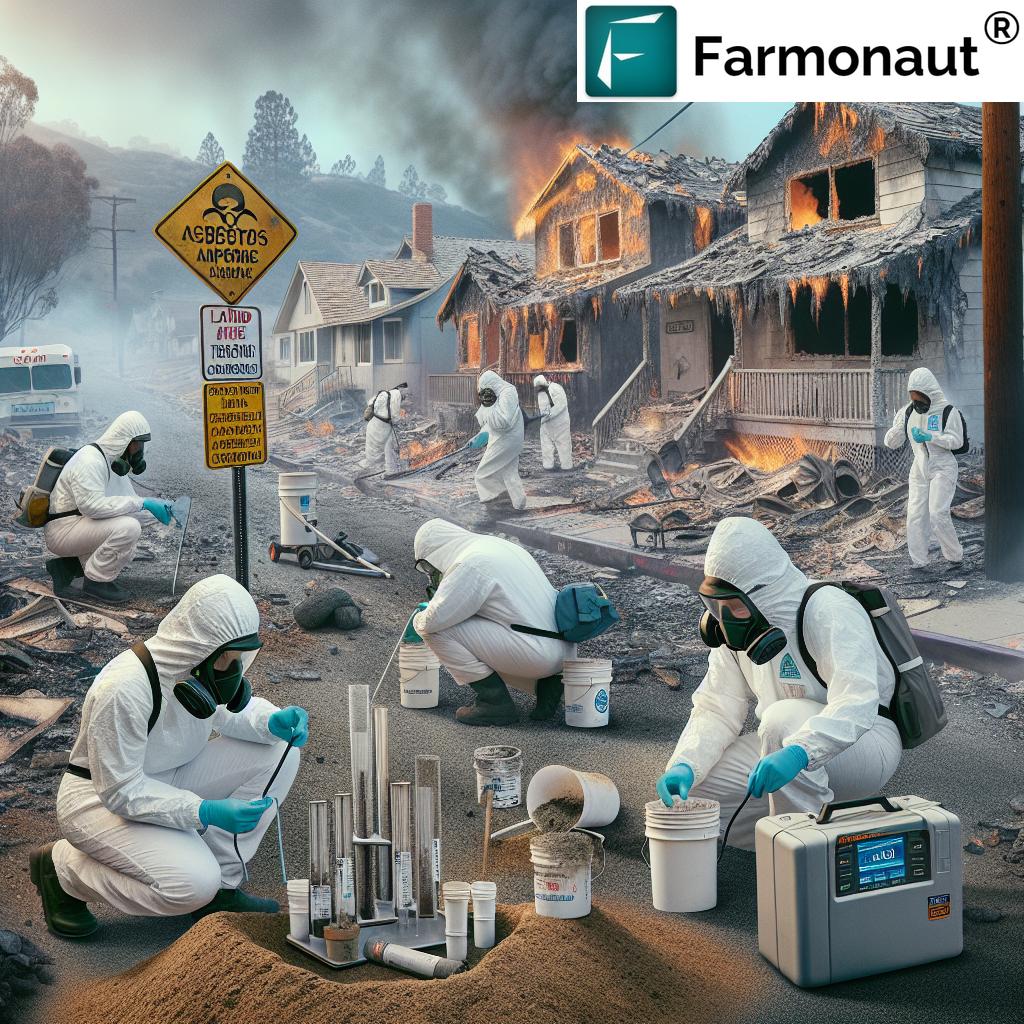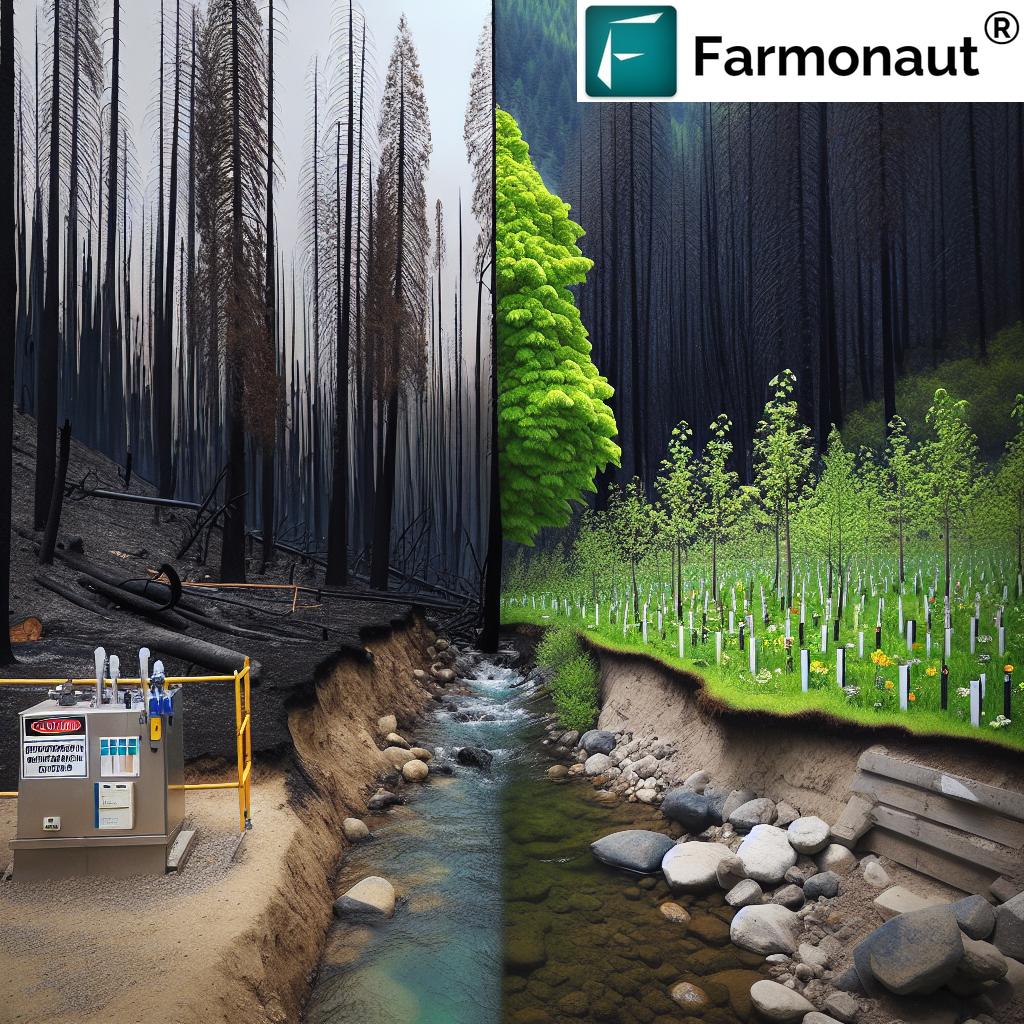California Wildfire Aftermath: Navigating Environmental Health Risks and Safe Return to Homes
“California wildfires can release up to 5 times more pollutants than the state’s total annual vehicle emissions.”
In the wake of devastating wildfires that have ravaged California, we find ourselves grappling with a complex web of environmental health risks and challenges. As residents of affected areas like Altadena and Los Angeles County strive to return to their homes, the aftermath of these fires presents a daunting landscape of potential hazards and uncertainties. In this comprehensive guide, we’ll explore the long-term impacts of wildfires on soil contamination, air quality, and water safety, while providing crucial insights into navigating the complex process of returning home safely.
The Scope of California’s Wildfire Crisis
The recent Eaton Fire in Altadena is just one chapter in California’s ongoing battle with wildfires. These catastrophic events have scorched over 55,000 acres in Los Angeles County alone, claiming 25 lives and destroying more than 16,000 structures. The scale of destruction is staggering, but it’s the invisible threats left behind that pose an equally significant challenge to public health and safety.

Understanding the Hidden Dangers
While the immediate threat of flames may have subsided, the environmental health risks in wildfire-affected areas persist long after the smoke clears. Residents like Anita Ghazarian and Simon Penny face a perplexing situation: their properties may appear intact, but the surrounding environment harbors invisible dangers that could impact their health for years to come.
- Soil Contamination: Wildfires can release a cocktail of toxic substances into the soil, including heavy metals, polycyclic aromatic hydrocarbons (PAHs), and other hazardous materials.
- Air Quality Degradation: Even after visible smoke dissipates, fine particulate matter and volatile organic compounds (VOCs) can linger in the air, posing respiratory risks.
- Water Safety Concerns: Ash and debris can contaminate water sources, potentially introducing harmful chemicals and pathogens into drinking water systems.
These environmental health risks associated with wildfires demand our attention and action. As we delve deeper into each aspect, we’ll explore how advanced technologies, including remote sensing solutions like those offered by Farmonaut, can play a crucial role in monitoring and assessing these hazards.
Soil Contamination: A Hidden Threat Beneath Our Feet
One of the most insidious consequences of wildfires is soil contamination. The intense heat and combustion of various materials release a plethora of toxins that settle into the earth, potentially affecting everything from groundwater to the food chain.
- Lead Contamination: Old paint, plumbing, and other building materials can release lead into the soil when burned.
- Asbestos Exposure: Older structures may contain asbestos, which can become friable and contaminate the surrounding area during a fire.
- Persistent Organic Pollutants: Dioxins and other long-lasting contaminants can be produced during the burning of certain materials.
The implications of soil contamination extend far beyond immediate health concerns. Long-term exposure to these toxins can lead to chronic health issues, including cancer and developmental problems in children.
Air Quality: The Invisible Menace
While the thick smoke of active wildfires is an obvious air quality concern, the aftermath presents more subtle but equally dangerous risks. Fine particulate matter (PM2.5) can remain suspended in the air for weeks after a fire, easily inhaled deep into the lungs.
- Volatile Organic Compounds (VOCs): These gases, released from burned materials, can cause respiratory irritation and long-term health effects.
- Ash and Dust: Stirred up by wind or human activity, contaminated ash and dust can become airborne hazards.
- Mold and Fungi: In the aftermath of fire suppression efforts, damp conditions can lead to mold growth, further compromising air quality.
Monitoring air quality in wildfire-affected areas is crucial for public health. Advanced remote sensing technologies can play a vital role in tracking these invisible threats across large areas.
Water Safety: Ensuring Clean Drinking Water
The impact of wildfires on water safety is often overlooked but can have far-reaching consequences. Contamination of water sources can occur through various mechanisms:
- Ash and Debris Runoff: Rain can wash contaminants into streams, rivers, and reservoirs.
- Damage to Infrastructure: Fires can compromise water treatment facilities and distribution systems.
- Chemical Leaching: Heat-damaged pipes can leach harmful substances into the water supply.
Ensuring safe drinking water in the aftermath of wildfires requires comprehensive testing and monitoring programs. Residents should be cautious about using water from potentially affected sources without proper verification.
The Challenge of Safe Return
For residents like those in Altadena, the decision to return home after a wildfire is fraught with uncertainty. The lack of a coherent system for testing contaminants leaves many feeling vulnerable and unsure about the safety of their environments.
“Post-wildfire soil contamination can persist for over 100 years, affecting ecosystem recovery and human health long-term.”
This long-term persistence of contaminants underscores the importance of thorough environmental assessments before reoccupation. However, the current landscape of testing and cleanup efforts is often disjointed and inadequate.
The Role of Technology in Wildfire Aftermath Assessment
Advanced technologies are increasingly playing a crucial role in assessing and monitoring wildfire-affected areas. Remote sensing solutions, such as those provided by Farmonaut, offer powerful tools for mapping and analyzing environmental impacts across large areas.
- Satellite Imagery Analysis: High-resolution satellite data can help identify areas of severe burn and potential contamination hotspots.
- Multispectral Imaging: This technology can detect changes in vegetation health and soil composition, indicating areas of concern.
- AI-Driven Data Processing: Advanced algorithms can process vast amounts of data to provide rapid, accurate assessments of environmental conditions.
By leveraging these technologies, we can gain a more comprehensive understanding of the environmental impacts of wildfires and better target cleanup and remediation efforts.
Navigating the Cleanup Process
The wildfire cleanup process is complex and multifaceted, involving various stakeholders and agencies. Understanding this process is crucial for residents seeking to return home safely.
- Initial Assessment: Government agencies and environmental experts conduct preliminary evaluations of affected areas.
- Hazardous Material Removal: Specialized teams remove obvious sources of contamination and hazardous debris.
- Soil and Water Testing: Comprehensive testing is conducted to identify less visible contaminants.
- Remediation Planning: Based on test results, plans are developed for soil removal, water treatment, and other necessary interventions.
- Implementation of Cleanup Measures: This may include soil excavation, water system flushing, and air quality improvement measures.
- Ongoing Monitoring: Long-term monitoring programs are established to track environmental recovery and identify any emerging issues.
Throughout this process, clear communication between authorities and residents is essential. However, as we’ve seen in cases like Altadena, this communication is often lacking, leaving residents to navigate complex decisions with incomplete information.

Community Action and Grassroots Efforts
In the face of institutional gaps, many communities have taken matters into their own hands. Social media groups and community organizations have become hubs for information sharing and mutual support.
- Independent Testing Initiatives: Residents pooling resources for comprehensive soil and water testing.
- Information Sharing Networks: Online platforms where community members share test results, remediation strategies, and insurance claim advice.
- Advocacy Groups: Organizations pushing for more transparent and comprehensive government response to wildfire aftermath.
These grassroots efforts highlight both the resilience of affected communities and the pressing need for more robust official support systems.
Long-Term Health Implications
The health impacts of wildfire exposure can extend far beyond the immediate aftermath. Understanding these potential long-term effects is crucial for residents and healthcare providers alike.
- Respiratory Issues: Chronic exposure to particulate matter can lead to long-term lung damage and exacerbate conditions like asthma.
- Cardiovascular Risks: Fine particles can enter the bloodstream, potentially increasing the risk of heart disease and stroke.
- Mental Health Concerns: The stress and uncertainty of displacement and potential health risks can lead to anxiety, depression, and PTSD.
- Cancer Risks: Long-term exposure to certain contaminants released during wildfires may increase cancer risk.
Monitoring these health impacts requires a coordinated effort between public health officials, healthcare providers, and environmental scientists. Long-term studies of affected populations are essential to fully understand and address these health risks.
The Role of Government and Policy
Addressing the environmental health risks of wildfire aftermath requires a coordinated and comprehensive government response. However, current efforts often fall short of what’s needed.
- Regulatory Gaps: Lack of clear standards for post-wildfire environmental safety.
- Funding Challenges: Insufficient resources allocated for comprehensive testing and cleanup efforts.
- Interagency Coordination: Need for better cooperation between local, state, and federal agencies.
- Public Communication: Improving transparency and information dissemination to affected communities.
Policymakers must prioritize the development of clear, science-based guidelines for assessing and addressing wildfire aftermath risks. This includes establishing standard protocols for environmental testing, cleanup, and long-term monitoring.
Innovative Solutions and Future Directions
As we face an increasing frequency and intensity of wildfires due to climate change, innovative approaches to managing their aftermath are crucial. Several promising avenues are emerging:
- Advanced Remote Sensing: Utilizing satellite and drone technology for rapid, large-scale environmental assessments.
- AI-Driven Predictive Models: Developing algorithms to predict potential contamination patterns based on fire behavior and landscape characteristics.
- Bioremediation Techniques: Exploring natural methods for soil and water decontamination using plants and microorganisms.
- Community-Based Monitoring Programs: Empowering residents with tools and training to participate in long-term environmental monitoring efforts.
These innovative approaches, combined with robust policy frameworks and community engagement, offer hope for more effective management of wildfire aftermath in the future.
Explore Farmonaut’s API for advanced environmental monitoring solutions
Practical Steps for Residents
For those facing the daunting task of returning to wildfire-affected areas, here are some practical steps to ensure safety:
- Await Official Clearance: Do not return to your property until authorities have deemed it safe to do so.
- Conduct Independent Testing: Consider hiring certified professionals to test soil, water, and air quality on your property.
- Use Protective Equipment: Wear appropriate PPE when visiting or cleaning up your property.
- Be Cautious with Water Use: Have your water supply tested before using it for drinking, cooking, or bathing.
- Monitor Your Health: Be aware of any unusual symptoms and seek medical attention if concerns arise.
- Stay Informed: Keep up to date with official announcements and community resources.
- Consider Professional Cleanup: For extensive contamination, professional remediation services may be necessary.
Remember, the invisible threats in wildfire aftermath can be just as dangerous as visible damage. Prioritizing health and safety is crucial during the recovery process.
The Path Forward: Building Resilience
As California and other wildfire-prone regions grapple with the increasing frequency and intensity of these disasters, building resilience becomes paramount. This involves not just responding to individual fire events, but developing comprehensive strategies for long-term adaptation and risk reduction.
- Improved Building Codes: Implementing fire-resistant construction standards in vulnerable areas.
- Landscape Management: Adopting practices that reduce fire risk in urban-wildland interface zones.
- Community Preparedness: Developing robust evacuation plans and community-wide emergency response protocols.
- Environmental Monitoring: Establishing ongoing monitoring programs to track long-term environmental health in fire-prone regions.
By taking a proactive approach to wildfire preparedness and aftermath management, we can work towards creating safer, more resilient communities in the face of this growing environmental challenge.
Check out Farmonaut’s API Developer Docs for integrating environmental data into your applications
Conclusion: A Call to Action
The aftermath of California’s wildfires presents a complex challenge that requires a multifaceted approach. From addressing immediate environmental health risks to developing long-term resilience strategies, there is much work to be done. As we navigate this challenging landscape, it’s crucial that we:
- Prioritize comprehensive environmental testing and monitoring
- Improve communication and transparency between authorities and affected communities
- Invest in innovative technologies for environmental assessment and remediation
- Develop clear, science-based guidelines for safe return and long-term habitation in affected areas
- Support ongoing research into the long-term health impacts of wildfire exposure
By working together – residents, scientists, policymakers, and technology innovators – we can build a safer, more resilient future in the face of California’s wildfire challenges. The road to recovery may be long, but with determination, innovation, and community spirit, we can overcome these environmental health risks and create a sustainable path forward.
Post-Wildfire Environmental Health Risks and Mitigation Strategies
| Environmental Hazard | Potential Health Impacts | Detection Methods | Mitigation Strategies |
|---|---|---|---|
| Soil Contamination | Long-term exposure risks, potential cancer risk, developmental issues | Soil testing, remote sensing analysis | Soil removal, bioremediation, phytoremediation |
| Air Quality Degradation | Respiratory issues, cardiovascular problems, exacerbation of existing conditions | Air quality monitors, satellite-based particulate matter tracking | Use of air purifiers, wearing masks, limiting outdoor exposure |
| Water Safety Issues | Gastrointestinal illnesses, long-term health effects from chemical exposure | Water quality testing, monitoring of water sources | Water treatment systems, use of bottled water, flushing of water systems |
| Hazardous Materials Exposure (e.g., lead, asbestos, VOCs) | Acute and chronic toxicity, neurological effects, respiratory issues | Specialized testing for specific contaminants, material analysis | Professional removal and disposal, use of protective equipment, area containment |
FAQ Section
Q: How long after a wildfire is it safe to return home?
A: The safety timeline varies depending on the extent of damage and environmental contamination. Always wait for official clearance from authorities, which can take weeks to months. Even after returning, be cautious and consider independent testing of your property.
Q: What are the most common health risks associated with wildfire aftermath?
A: The most common risks include respiratory issues from air pollution, potential exposure to hazardous materials in soil and water, and mental health impacts from stress and displacement. Long-term risks may include increased cancer risk from certain contaminants.
Q: How can I test my property for contamination after a wildfire?
A: You can hire certified environmental testing companies to conduct comprehensive soil, water, and air quality tests. Some community organizations also offer testing resources. Remote sensing technologies can provide initial assessments of large areas.
Q: What should I do if I suspect my water is contaminated after a wildfire?
A: Immediately stop using the water for drinking, cooking, or bathing. Use bottled water or a certified safe source. Have your water tested by a qualified laboratory and follow guidance from local health authorities for treatment or alternative water sources.
Q: How long can wildfire contaminants persist in the environment?
A: Some contaminants, particularly in soil, can persist for decades or even over a century. The duration depends on the specific contaminants, environmental conditions, and remediation efforts.
Q: Are there any government programs to help with wildfire cleanup and contamination issues?
A: Yes, various federal, state, and local programs offer assistance. The Federal Emergency Management Agency (FEMA) provides some support, and state environmental agencies often have specific wildfire recovery programs. Check with your local government for available resources.
Earn With Farmonaut
Earn 20% recurring commission with Farmonaut’s affiliate program by sharing your promo code and helping farmers save 10%. Onboard 10 Elite farmers monthly to earn a minimum of $148,000 annually—start now and grow your income!
















